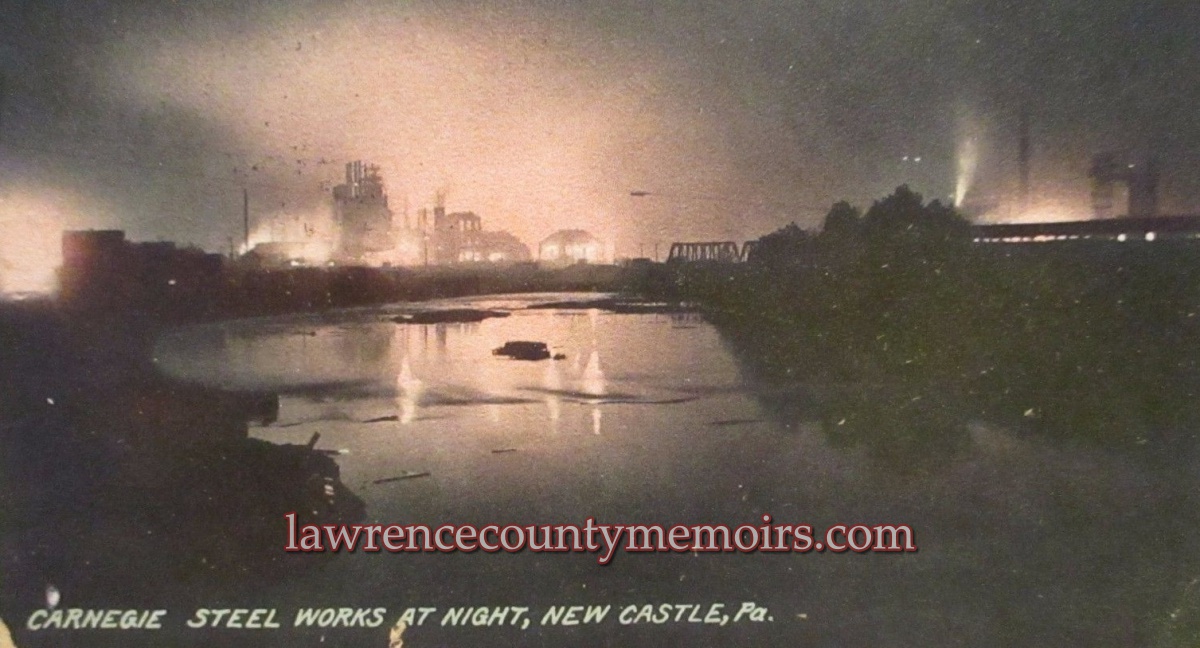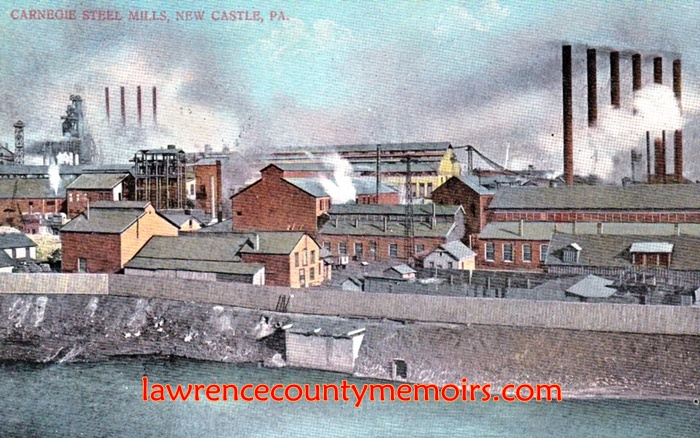In the summer of 1891 a group of businessmen from New Castle, Pennsylvania, banded together with the intention of building a steel plant in the thriving manufacturing city. The plant would be constructed on the former site of the Crawford Iron & Steel Company along the eastern banks of the Shenango River – just south of where the Shenango River and Neshannock Creek meet. The new plant, which opened in late 1892, was known as the Shenango Valley Steel Company and headed by President William E. Reis.
The steel making plant was a success and was enlarged and upgraded over the next decade. By the late 1890’s the city of New Castle was a major player in the manufacture of iron, steel, and tin plate and sometimes referred to as “Little Pittsburgh.” Shenango Valley Steel and a host of other plants in Pennsylvania and Ohio were swallowed up by the National Steel Company in 1898 and Reis was selected to head up that firm from corporate offices in New York City. Numerous other members of the Reis family, including brother John Reis who later served as vice president of the U.S. Steel Corporation, were also involved in the steel industry.
In 1903 the National Steel Company was merged with the Carnegie Steel Company, which had been under the control of the mega powerful U.S. Steel Corporation (headquartered in Pittsburgh) since it was formed in early 1901. The plant along the Shenango RIver became known as the New Castle Works of the Carnegie Steel Company.
The Carnegie Steel Company, which brought together a handful of steel plants, had been formed by the wealthy Scottish-born industrialist and humanitarian Andrew Carnegie in 1892. Carnegie had come to the Pittsburgh area as a poor youngster in 1848, rose up through the ranks of the railroad, oil, and iron industries, and made his fortune in the steel business during the 1880’s and 1890’s. Carnegie’s empire was bought out in 1901 for an astounding $480 million (over $13 billion in 2011 dollars) making him the wealthiest man in the world for a time. The deal led to the formation of U.S. Steel and made that outfit the first billion dollar corporation and the largest steel producer in the world.
The Carnegie interests also acquired other facilities in the city including the adjoining Rosena Furnace site along the Neshannock Creek. O. J. H. Hartsuff, a member of the prominent Hartsuff family of Croton and longtime employee of the Shenango Valley/Carnegie/U.S. Steel interests from 1891-1933, was superintendent of the profitable New Castle plant from 1906 until 1918.
In 1913 the Carnegie Steel Company built a large playground on its property along South Jefferson Street. The massive playground, which was only open during the summer months, featured an indoor auditorium for showing movies, an athletic field, and numerous pieces of recreational equipment such as swings, bars, and slides. Often as many as 2,500 kids visited the site on any given day. A dedicated playground staff hired by the company organized various activities for the kids and also sports leagues for adults.
Over the years various strikes shut down or hampered the operations of the Steel plant and other mills in New Castle. One of the most serious was the nationwide steel workers strike of 1919, when steel, iron, and tin mill workers organized to protect their interests in the wake of The Great War (World War I). The strike lasted from September 1919 until it basically collapsed in complete failure for the unions in January 1920. Strike activity and disturbances in the New Castle area were generally calm compared to other regions and the Carnegie Steel plant operated at a slightly reduced capacity throughout the strike.
The Carnegie Steel plant remained in operation throughout the 1920’s until the U.S. Steel Company (undergoing consolidation) closed it in mid-1931 during the tough times of the Great Depression. The popular playground was unfortunately closed as well. In 1938 most of the playground equipment, which had been disassembled and placed in storage, was given to the former Crawford-Oakridge Home for Girls on Atlantic Avenue, then operating as a National Youth Administration (NYA) Resident Center under the Works Progress Administration (WPA). The NYA facility was used to educate, train, and find work for underprivileged youths ages 16-24 and I assume the playground was used by the younger children of the local area.
The Carnegie Steel Company site along the Shenango River was razed and completely cleared during the mid-1930’s. In 1942 the United Engineering & Foundry Company built a large plant at the location that was paid for and owned by the federal government. The Pittsburgh-based company was a leader in making heavy castings to support the steel-making industry. The plant closed in December 1954 as United Engineering and the U.S. government could not work out a new lease agreement. In April 1956 the facility was auctioned off and purchased by the Mesta Machine Company of Pittsburgh. Mesta Machine, which also made heavy equipment for steel-making plants, was in operation until it was closed in 1982 due to financial hardships. A few years later the site became home to several steel manufacturing facilities associated with the Ellwood Group Inc. (EGI) of Ellwood City.
To read an editorial in the New Castle News mentioning how the newspaper was congratulated for putting out an extra edition upon announcement that a new steel plant would be built click on: CONGRATS EDITORIAL. To read two short articles mentioning that the location for the proposed Shenango Valley Steel Company was selected in 1891 click on: LOCATION ARTICLES. To learn more about repairs and upgrades being made at the plant in mid-1893 click on: REPAIRS WILL BE COMPLETED ARTICLE. A nationwide coal miner’s strike in mid-1894 shut down operations of most of the mills of New Castle. To read an article from early August 1894 about Shenango Valley Steel and other mills about to commence operations again click on: RESUMES OPERATIONS ARTICLE. To read an article mentioning the prominent rumor that Andrew Carnegie had sold for steel empire in early February 1901 click on: NOTHING KNOWN ARTICLE. Working in the steel plants was extremely dangerous at times and accidents were common. To read a few short articles about accidents that took place in 1905 alone click on: 1905 ACCIDENT ARTICLES. To read about the furnaces of the Carnegie plants being completely shut down in June 1905 click on: BLAST FURNACES BANKED ARTICLE. To read about an explosion at the Carnegie plant in July 1905 click on: EXPLOSION AT FURNACE ARTICLE. In late 1905 the Carnegie Steel Company purchased some nearby property containing old mills and began razing the buildings. To learn more about it click on: OLD INDUSTRIES ARE NOW BEING RAZED ARTICLE. To read about the city council considering swapping property with the Carnegie Steel Company click on: WILL ADVISE GIVING AWAY ARTICLE. To read about kids from the Carnegie playground getting rides in plant superintendent O. J. Hartsuff’s vehicle in 1913 click on: KIDS RIDE IN HARTSUFF’S CAR ARTICLE. To read three articles about the Steel Strike of 1919 and its effect in New Castle click on: PLANTS ARE IN OPERATION ARTICLE and MORE MILLS IN OPERATION ARTICLE and CARNEGIE PLANT TO OPERATE SUNDAY ARTICLE and MORE MEN RETURN ARTICLE. To read a column listing the effects of the strike in other areas click on: REPORT FROM VARIOUS CITIES. The strike ended in collapse in early January 1920. To read a short article about the strike being ended click on STEEL STRIKE IS OFFICIALLY OFF ARTICLE. To read an article from 1920 that describes the Carnegie playground in detail click on: THRILLS GALORE ARTICLE. To read about a field day event at the Carnegie playground in August 1922 click on: FIELD DAY EVENT ARTICLE.
 The Carnegie Steel plants light up the night sky in downtown New Castle. (1908) |
 The mills of Carnegie Steel/U.S. Steel were serviced by several railroads, which brought in raw materials such as iron ore, limestone, and coal and hauled away finished steel products. The company operated and owned extensive properties along the confluence of the Shenango River and Neshannock Creek to include an office building, the main steel making plant, several blast furnaces known as the McKinley (Raney), Red Jacket, and Rosena (Oliver), a large playground, and several sports fields. (c1910) Full Size |
 The steel making plant was a success and was enlarged and upgraded over the years. By the late 1890’s the city of New Castle was a major player in the manufacture of iron, steel, and especially tin plate and was sometimes referred to as “Little Pittsburgh.” (c1910) Full Size |
 The company-funded Carnegie Playground along South Jefferson Street was built in 1913 and was a very popular summer hangout for the local children. In the background is an auditorium where movies were shown. This playground was an unfortunate casualty when U.S. Steel shutdown its New Castle plants in 1931. (c1915) Full Size |
 When U.S. Steel closed down its once-thriving New Castle plants in the early days of the Great Depression it was a blow to the community. Other steel plants have been in business since, but nothing would compare to the scope of the old Carnegie/U.S. Steel operations of the early 1900’s. (c1910) Full Size |
 Some sort of activity being organized on the playground of the steel mill. (c1915) Full Size |
 An old set of keys with a fob marked as the “New Castle Works” of the Carnegie Steel Company. (Jan 2012) Full Size |










Comments
Terry Dean #
I found a check fob and was wondering if there was anyway to find out who it belonged to so that I might be able to return it to family.
EUGENE HOOVER #
MY GREAT UNCLE CLIFFORD HOOVER WORKED AT STEEL PLANT EARLY 1900 AT THE MELT SHOP
Comment